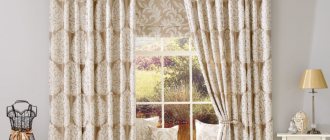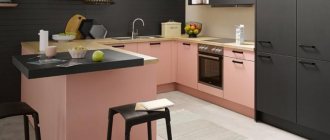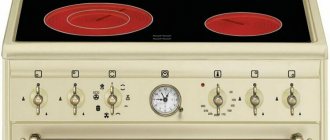What is a railing system and why is it needed?
The word “railing” itself comes from the English “rail”; it can be translated as “crossbar”, “hanger” or “rail”. Simply put, a roof rail is “the stick on which everyone hangs in the kitchen.”
The basis of the railing system is a galvanized pipe, which is most often attached to the wall. Pipes vary in length, size and cross-sectional shape - they can also be flat. Decorative caps are used at the ends.
In addition to the technical characteristics, housewives can choose the design of the railing - its color and surface, for example, matte or glossy. Properly selected accessories will emphasize the style and advantages of a particular kitchen.
Functionality and aesthetics are based not on the railing itself, but on its content. It can be:
- hooks for kitchen utensils;
- spice jars;
- dryers for dishes or cutlery;
- and even lamps.
Most often, the railing system is installed under wall cabinets. But you can also find more original options, for example, above the island or near the countertop.
The location is selected according to the hostess’s taste, but it is this that plays the most important role in the future convenience of cooking.
Ideally selected roof rails will save a lot of time and effort when preparing food, as they will provide quick and easy access to frequently used kitchen equipment.
Types of systems
There are three types of roof rails for the kitchen. The most commonly used horizontal railing system for the kitchen, as housewives appreciate the convenience of placement under wall-mounted kitchen cabinets and in any horizontal plane. They can be placed along all hanging cabinets, if this is rational, or separated into functional modules. The heart of each hanging system is all kinds of hooks and additional elements. The range of accessories is unlimited: hooks, shelves, trays, holders.
The simplest railing option is a straight tube with S-shaped hooks
A popular type of system is a magnetic rail for storing metal objects without hooks. It is especially convenient to store knives this way.
A magnetic strip for knives attached to the apron will free up space on the kitchen worktop
Vertical railing for the kitchen consists of a more massive base tube, compared to the horizontal system, and hanging elements: shelves and holders. They can be single-tiered or multi-tiered. Dishes, jars, bottles, and food are most often stored on the shelves of this system. They are attached between the cabinet and the countertop or from the ceiling to the floor.
Bar counters are often equipped with vertical rails
A suspended kitchen rail is a single structure that is attached to the ceiling. As a rule, this is a whole system where there is a place for dishes and other accessories. Bars take advantage of this. It is especially in demand by owners of island-type kitchens, where the system is located above the work table.
Railing in original wooden case suspended on chains
Options for roof rails for the kitchen are shown in the photo.
Advantages of roof rails in the kitchen
Thanks to the railing system, the work area becomes more spacious, freer and neater. The advantage is that you can create a unique system specifically for your kitchen.
This solution is especially relevant for small kitchens, where saving every centimeter of space is important. But there are other positive aspects that should not be kept silent:
- the presence of a well-thought-out railing system can be a reason to refuse the upper set - this will make the room as free, spacious and comfortable as possible;
- all the necessary items are located close - not only space is saved, but also time;
- such systems can withstand high mechanical loads without deforming or losing their presentable appearance;
- The railing elements are mobile - they can be put on, removed or simply swapped. And the system itself can be located anywhere in the kitchen;
- the roof rails do not require any complicated maintenance - it is enough to occasionally brush off the dust and wipe them with a sponge and detergent;
- the market offers a huge variety of models in shape, color and size - you can bring any idea to life, and this applies not only to the roof rails themselves, but also to their accessories;
- low cost of the entire system;
- Simple installation that even a beginner can handle with his own hands.
The only drawback of such a system is that in some cases there may be a feeling of disorder and clutter. To avoid this, you don’t have to put out your best at once. It is better to leave really necessary things that are often used on the railing.
What does the railing system consist of?
There are several basic and most frequently encountered elements:
- the railing itself is a pipe or rod, the diameter of which is most often 1.6 cm. The length can be different - from 40 to 300 cm;
- holders are necessary components for attaching the rod to the wall. The quantity depends on the length of the pipe;
- plugs - decorative elements that are attached to the ends of the pipe;
- corner adapters and couplings (optional) - used to connect two adjacent shelves. The coupling is used inside the rod, the adapter is used outside.
In addition to the basic elements, a competent storage system also requires accessories. They are selected and purchased by the owner herself, based on her own needs and ideas.
Materials and colors
There are many different types of roof rails available on the market. They are made from:
- of stainless steel;
- brass;
- brushed nickel;
- polymers;
- aluminum;
- tree.
But do not forget that the environment in the kitchen is quite aggressive, so not every material is suitable for railing near the work area. Vapors, flying drops of fat, and high humidity can damage the structure, reducing functionality and spoiling the appearance of the system.
Installation and mounting methods
Installing the railing is quite simple and does not require special skills: anyone can do it with their own hands.
The structure itself can be long and stretch along the entire set, or, conversely, it can be several small pendants at different points. It usually takes no more than an hour to attach a kitchen railing system.
The entire installation process consists of 4 steps:
- First of all, you need to install the holders. To do this, a hole with a diameter of 6–8 mm is drilled in the wall or kitchen apron, into which a dowel is inserted. Usually all the necessary screws and dowels are included in the kit.
- The holder is attached to this dowel using a screw.
- After the holders are installed, it's time to attach the railing to them.
- The final stage can be called installing the plugs.
The holders are installed at a distance of 50–60 centimeters from each other, so their number is optional and depends on the length of the railing. The main thing is to make sure that the bar with hooks does not bend under the weight of the accessories.
But proper installation is not enough for maximum practicality and functionality. It is also necessary to decide on the place where the railing system will be hung. Usually it is hung at a height of 45–50 centimeters above the tabletop. If there is a hanging set, then the system should be at least 5–6 centimeters lower than it.
There are also more original ways of fastening a railing system without a holder. They are usually accompanied by instructions and a mounting profile that must be mounted on the wall.
If you have doubts about your own abilities, it is better to contact an installation specialist. In this case, the railing system will definitely be hung securely, aesthetically and conveniently.
After the installation is completed, you can begin filling the railing with accessories. This is a simple and interesting process, since all accessories are mobile and interchangeable.
horizontal - was discussed above . As the name implies, its essence is that the fastening occurs parallel to the working area. But this is not the only way to install the railing - there are other options:
- Vertical method - most often used in corners or on bar counters, maximizing their functionality. Fastening occurs perpendicular to the working area.
- Hanging method - used in large kitchens, most often with an island. This technique has moved into private apartments from catering kitchens, where everything should be at hand. Rails are suspended by chains or cables from the ceiling above a work area, island, or any other location. In this option, it is especially necessary to be sure of the reliability of the ceiling or fastenings.
with suction cups stand apart . They are convenient because at any time the barbell with hooks can be removed or simply moved to another place. But the disadvantage of this solution is that it will not be possible to heavily load the pipe - the suction cups will not hold up. But towels, oven mitts and light dishes will feel great.
Rails: fastenings, at what height to hang them
Railings in the kitchen are an excellent solution for organizing the kitchen
Railings are horizontal parts, the base of which is presented in the form of a plank:
- usually they are located in a horizontal position;
- it is preferable to use them in the apron area or along the side walls;
- if the design allows, the rails are placed on the decorative front parts of the hood, that is, they are located almost under the ceiling;
- Shelves or hooks are installed on the roof rails. They are very convenient for this purpose, since the number of elements can be constantly changed, adapting the installation to your own needs.
Sometimes railing systems are installed in a vertical position. This is only necessary to create an unusual design, sometimes to save space. In this case, a long strip is needed, which is attached by joining to the ceiling above and to the floor below. Such interior parts are most often sold in metal, but it is possible to purchase options made of glass, plastic or wood.
Modern roof rails often have additional fastening elements, thanks to which you can hold glasses, baskets with food or small items. Comfortable, often voluminous stands can be attached to them.
Railings in a vertical position sometimes provide for mounting a small stand on them in the form of a table. They can be used to organize a breakfast area or as an element of a home bar counter.
Kinds
Long
Apply to the entire wall along or across. Designed for kitchens with a large area. They add comfort to cooking and serve as a multifunctional design element. Suitable if wall cabinets do not fit into the interior design of the room. They perfectly replace their functions, without cluttering up the space with a series of objects in the same color.
In addition to roof rails, it is advisable to use hanging shelves to place heavier or bulkier items on them.
Multi-tiered
Designed to significantly save space in kitchens with a small area. They are usually arranged in a long vertical row and take up as much space as a kitchen cabinet would. Sometimes they are mounted in a place where there are no hanging shelves and cabinets or in an interior without top drawers, that is, they are located between volumetric elements.
Circular
Circular ones are often used on bar counters
Useful for placing towels, as well as small parts of kitchen equipment, such as knives. Suitable for placing spices on them or neatly placing plates of fruit. They can also serve as a mount for a stand on which you can place any elements while cooking. These are stylish, modern options, while the design is suitable for both classic kitchens and modern design. How to arrange a kitchen counter, you will also need rails here, read here.
Circular rails are often used to attach a variety of drawers. To do this, a plug is mounted on them, on which the panel is in turn placed. These parts snap into place during installation.
Location options
Most often, roof rails are placed in the area of a ceramic apron in a horizontal version. If they are installed vertically, they are usually complemented by furniture, that is, they serve to hold fairly large objects. When choosing a height, you should be guided by your own taste and preferences; strict instructions are not given.
If you plan to attach hooks to the rails and hang any tools on them, then it is advisable to place them in the upper part of the wall. If you install shelves or various cleaning products on them, you can place the rails in the middle or in the lower compartment of the room. Read how to equip a small kitchen in a Khrushchev building here.
Recommendations for optimal placement of roof rails:
- If the kitchen is completely made in a minimalist style or is equipped with elements of Japanese culture, you will have to abandon the roof rails, since it is almost impossible to fit them in harmoniously. The only exception will be glass rails, on which only aesthetic elements are placed.
- Italian interior and Provence require the presence of rails on which any elements can be installed. You need to care not about the beauty of the device, but about its practicality, so these elements can be placed anywhere. When using them, it is advisable to protect the interior from the use of various wall cabinets, since a single-color shade is not suitable for the given design, but to replace them with bright furnishings.
- When purchasing rails for walls in a chalet or country style, it is preferable to attach them to the ceiling, localizing them near the main elements of the kitchen unit. You can hang dried herbs, vegetables or roots next to the shelves attached to the rails, which will create a natural look.
- Rails with clothespins will help you create a whole garden of any flowers in your kitchen. Vegetation is planted in pots with hanging mounts, and rails are attached directly to the ceiling. Along with flowers, you can hang any paintings and photographs, after making them laminated.
- Rails can be attached in those places where housewives prefer to regularly take necessary items. For example, if you constantly use potholders hung on a hook from the railing, it would be advisable to place this element next to the stove at the level of human height.
- If you choose a high-tech design, then before placing the roof rails you will have to choose the most optimal place for them. It is advisable to take more hooks, then it will be possible to hang the maximum amount of kitchen utensils. In this case, it is advisable to choose options made of nickel or chromium. They are placed in a visible place, often near the sink or slightly outside the apron area.
Everything is at hand - convenient.
Where can I hang it?
The most common location of the railing is on the apron near the work area. Yes, this is convenient because you can store all the necessary items here while cooking, but there are many more options:
- at the end of the furniture;
- above the stove - it’s convenient to place pans, spices or a shelf for a cookbook here;
- above the sink is an excellent place for a dish drainer or a shelf with household chemicals, sponges and rags;
- in a ledge or niche;
- next to the kettle or coffee machine - you can set up a real coffee bar;
- on a free wall next to the set - you can place several rails in a row, creating an ideal storage system;
- on the door - but it’s better not to store anything breakable;
- above the bar counter is an ideal place to store glasses.
More ideas in the video:
Installation of horizontal railing
A convenient place to place the railing is the part of the wall above the working surface of the table, which is traditionally covered with a tiled apron. Typically, the space on the wall above the hob is not used for hanging small items necessary for the housewife. This is due to the proximity to the fire and steam from dishes being cooked on the stove.
The tools necessary for preparing food should be at arm's length. To make it convenient to use, you need to determine at what height the railing is hung in the kitchen. Designers' recommendations call the optimal distance from the chest to eye level. For large cookware, which includes frying pans and all kinds of ladles, a parallel section of the railing is installed. This case is considered if there are no wall cabinets in a certain part of the kitchen. If wall cabinets are present, the railing is placed 5-8 centimeters below them.
Practical and stylish accessories and attachments
There are a great variety of accessories for railing systems on the market now. All of them are beautiful and comfortable, but still differ in size, configuration and purpose.
A thoughtful selection of accessories allows you to increase the number of items that can be placed.
There are several groups of standard models that are most often found on roof rails.
Mesh shelves and baskets
They can be of any shape:
- rectangular;
- round;
- oval;
- square;
- and any other configuration.
Don't miss: Magic corner for the kitchen - all about choosing and installing a magic mechanism
The main task of such a shelf or basket is to save space on the work surface. The most commonly used cooking spices or just a sponge for washing dishes can be stored here. On larger specimens you can even put flowers in pots or just fruits. If the kitchen is small, then you can place a coffee grinder, a small mixer, or just detergents on a mesh shelf like this.
Multifunctional hooks
Hooks in the kitchen, especially on railing systems, are difficult to overestimate. You can hang anything on them:
- frying pans;
- mugs;
- skimmers;
- cutting boards;
- ladles;
- towels;
- potholders, etc.
And this is all thanks to the simple and unpretentious shape of the hook. A railing system with hooks can be hung not only in the work area, but, for example, above an island or in a special niche. If you make a multi-level system, you will get a functional and stylish element of the kitchen.
Holders
Due to its considerable size, the holder may seem like a useless item to some, but true connoisseurs of order know that it is an indispensable accessory. You can attach to the holder:
- foil;
- cling film;
- paper towel.
Quick access to these items is very important in the process of preparing gourmet dishes. In addition, the holder allows you to tear off or cut off the required piece in almost one movement, which is very valuable, especially if your hands are marinated for meat.
Often there is not enough space on the work surface for a cookbook or a tablet with a recipe. Even if there is enough space, there is not always a desire to place them on the countertop, since there is a risk of getting dirty with drops or juice of the same vegetables and fruits.
The holder will help with this too - the book will be located nearby, it will be even more convenient to look through the recipe and you won’t have to take time off from cooking.
Rest
The variety of accessories does not end with the options listed. You can also find:
- glasses for drying equipment or storing them;
- dish dryer;
- holder for pots and pans lids;
- knife holder;
- holder for boards or books;
- hot stand;
- spice rack;
- shelf for wine glasses;
- bread box and so on.
The most common item stored on a roof rail, besides utensils, is spices. For example, IKEA has even developed special jars for storing seasonings for roof rails. Their lid is made in the shape of a hook. Option two:
- you can remove the jar and then open it;
- Or you can simply unscrew the jar and leave the lid hanging on the pipe.
Accessories for roof rails
A rail is a pipe for placing hanging accessories. The functionality of the system as a whole depends on the competent selection of such a design and the placement of objects on it.
- Hooks. Kitchen utensils are placed on them: skimmers, spatulas and ladle, oven mitts, towels. Pans and ladles are hung on these hooks.
- Railing shelves are suitable for storing a variety of things. They contain detergents and cleaning products, jars for seasonings and bottles with vegetable oil and vinegar.
- Dryers. Convenient for storing frequently used dishes and cutlery. They have a mesh design.
- Kitchen holders. Another type of hanging system on which you can attach, for example, rolled paper towels, foil and cling film. In the advanced version, they are equipped with a serrated edge to tear the material easily and evenly.
- Magnetic holders. They are a bar on which knives are attached.
- Seasoning jars. They have a lid in the form of a hook hooked onto a rod. The jars look original on the railing in the work area, especially if you pour brightly colored spices into them.
- Shelves. An independent element of a suspended structure. It is mounted in the upper tier. Available in different sizes. The large ones can accommodate small household appliances: a blender, mixer or microwave oven.
Tips for choosing
Experienced kitchen interior designers share several rules that will help you choose and install roof rails:
- It is necessary to make maximum use of space planning opportunities. To do this, you need to carefully consider the number of hooks, shelves, holders and other elements.
- When choosing and placing accessories, it will be correct to take into account its purpose. For example, spice jars would be best placed next to the stove, while a basket with a sponge would be best placed by the sink.
- The fastening must be as strong and reliable as possible, since over time the pipes may begin to sag and put additional pressure on the fastening elements. In the worst case, the railing system may collapse, which is completely unsafe.
- On the one hand, it would be logical to place ladles, ladle and skimmers on hooks next to the stove. But this way they will be constantly splashed with drops of fat, so it is better to hang them near the work area.
- When thinking about what to hang on the railing, you should focus only on the most frequently used items such as a ladle, a sponge for washing dishes, a towel, a container for oil or spices. You should not oversaturate the space, as this is not practical, as it might seem at first glance.
- If frying pans will hang on the rails, they must be in perfect condition not only from the inside, but also from the outside. If greasy drops or traces of burning are visible on the bottom, then this does not paint either the kitchen or the housewife.
- Among the variety of roof railing accessories, it is worth paying attention not only to beauty and functionality, but also to the quality of the product. Since the climate in the kitchen is difficult, a low-quality product will quickly lose its presentable appearance and may even become deformed. European parts from Germany, Italy, France, the Czech Republic, and Holland are most valued.
- The main rule for choosing the location of the railing is that the owner must reach it without taking extra steps.
- The most frequently used items should be placed closer to you. Things that are rarely used are either removed altogether or moved further away.
- Most often, 1-3 small rails will be enough. Even in a fairly spacious kitchen of 12 square meters. It’s better not to use more than three 60-centimeter rods, so as not to visually clutter or overload the space.
- Metal rails should be combined with the rest of the fittings in the kitchen.
What materials are used to make roof rails?
Kitchen rails can be made of different materials: brass, steel, stainless steel, nickel, anodized aluminum.
To give the product a more aesthetic appearance, chrome plating is often applied to it.
All railing elements (plugs, hooks, fastenings) are made in the same color.
However, there are other options for making metal rails: depending on the style of the kitchen and its interior, the rails are coated with gold, bronze, or copper.
Also, the product can be made in black or any other color - such a coating not only makes the metal strip more attractive, but also protects it from corrosion and moisture.
When choosing a roof rail from a particular material, you should definitely take into account the future load on it. The most durable and reliable is a metal product.
To arrange small sections, it is worth using anodized aluminum strips.
Stainless steel has the greatest resistance to all adverse external influences. In addition, it can withstand maximum weight.
The best manufacturers and their features
The variety of roof rails on the market lies not only in shapes and sizes, but also in different manufacturers. Many of them, due to the simplicity of the system, have a good reputation and positive feedback from consumers. Let's look at the most popular ones .
| Manufacturer | Main characteristics |
| IKEA | The Swedish company was one of the first to promote the idea of roof rails on the Russian market. Now she has a huge assortment that allows her to make any desire come true. One of the latest innovations is a special system on rails for growing indoor plants - this is a non-standard application. |
| Leroy Merlin | Leroy Merlin, under its own brand Delinia, produces fairly high-quality products that are budget-friendly. The feature is the same - a huge variety of goods. |
| Lemi | As a true Italian brand, Lemi focuses on the perfect design of details. Accessories can be chosen in any style and color, there is even a special “black velvet” coating. Of course, the quality is also high. |
| Lemax | The enormous popularity of this brand is ensured by its budget price and good quality parts. It is made in China, but lasts a long time and collects positive customer reviews. |
| Kessebohmer | A German brand for which functionality and practicality come first. You can find absolutely different models - even in the form of carousels. Characterized by typical German quality. |
| Tescoma | A well-known Czech brand of tableware that has proven itself well on the Russian market. The manufacturer has no doubt about the quality of its products, therefore it provides a guarantee of 5 years. |
| Starax | Turkish brand founded in 1996. Popular not only in Europe, but also in Asia. It produces roof rails not only from stainless steel, but also from other materials. Huge range of models. |
| Hettich | Another German brand. It has a high price tag, but this fact is compensated by the excellent quality of the product. In addition to reliability and durability, roof rails are also distinguished by their aesthetic beauty. |











